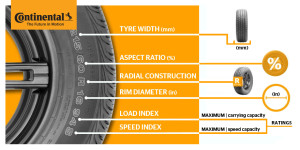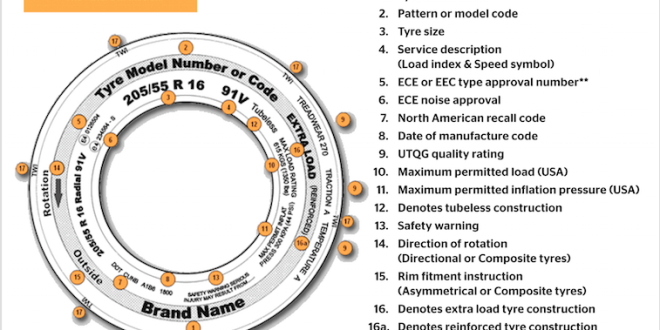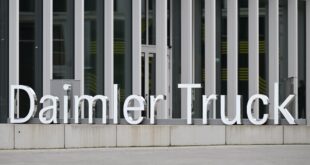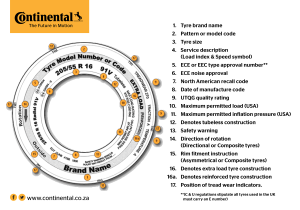
Decoding the information on tyre sidewalls is getting tougher and tougher for the layman. And no wonder, as the number of different specifications is steadily increasing, which means tyre manufacturers like Continental, who supply original equipment to vehicle manufacturers, have to add more indicators to the sidewall.
These sequences of numbers, letters and in some cases symbols can help motorists identify the right tyre for their vehicle – an important consideration in order to achieve the best balance of tyre performance for acceleration, braking and cornering, as well as ride comfort, noise and rolling resistance.
Here’s an example of a sequence you may find on the sidewall of a Continental tyre, and how to decode it. In the case of “225/45 R 18 95 H SSR MOE”, the number “225” represents the width of the tyre in millimeters – so in this case the tyre is 225 mm wide. The “45” that follows is the aspect ratio – the height of the tyre sidewall as a percentage of its width, which equates to 101 mm for this tyre.
Next up is an “R”, which is short for “radial”. Today, radial tyres have almost completely replaced the cross-ply tyres that were the standard design until the 1980s. The figure “18” indicates the wheel rim diameter in inches, while “95” is the load index, indicating the maximum weight the tyre can bear. In this example, the tyre is rated for 650 kg.
Then comes the letter “H” which is the speed index, where “H” signals a maximum speed of 210 km/h. “SSR” indicates that this is a Continental “SelfSupportingRunflat” tyre, otherwise identified by “RF” or “Runflat”.
The abbreviation “MOE” tells us this is a Mercedes-Benz original equipment tyre with run-flat properties (E = extended mobility). The number of these manufacturer-specific codes is set to increase even further in years to come, as more and more automakers submit their own specifications to leading tyre manufacturers.
Additional markings
High-performance tyres often include “XL” after the size marking, or the word “Reinforced” on the sidewall. This refers to tyres with additional sidewall reinforcements, which are designed to cope with the additional forces created by high-speed driving, cornering and braking. “FR” is used on tyres with a flange rib, which incorporates additional rim protection features.
In the case of 4×4 tyres, “M+S” is short for “mud and snow”, referring to tyres that are suited to operating in adverse conditions. Specialised winter tyres for passenger cars, which feature a snowflake icon, are not sold in South Africa due to construction and compounds which are not appropriate for our climate.
Along with this data, the tyre sidewall carries lots of other information, too. One important item for drivers is the production date, indicated by what’s called the DOT code.
It’s made up of the letters DOT and two pairs of figures, separated by a forward slash. The first two numbers show the week the tyre was built; the last two indicate the year. So “36/16” means the tyre was built in the 36th calendar week (i.e. between September 5 and 11) in 2016.
This is important in order to determine the age of the tyre, as the rubber degrades over time. Tyres older than five years should be avoided in the interests of safety and reliable performance, and this can be further influenced by the manner and environment in which tyres are stored.
About Continental
Continental develops intelligent technologies for transporting people and their goods. As a reliable partner, the international automotive supplier, tire manufacturer, and industrial partner provides sustainable, safe, comfortable, individual, and affordable solutions. In 2015, the corporation generated sales of €39.2 billion with its five divisions, Chassis & Safety, Interior, Powertrain, Tires, and ContiTech. Continental currently employs approximately 215,000 people in 55 countries.
The Tire Division currently has more than 24 production and development locations worldwide. The broad product range and continuous investments in R&D make a major contribution to cost-effective and ecologically efficient mobility. As one of the world’s leading tire manufacturers with about 49,000 employees, the Tire Division achieved sales of €10.4 billion in 2015.
Continental Commercial Vehicle Tires is one of the largest manufacturers of truck, bus and commercial specialty tires worldwide. The business unit is continuously developing from a pure tire manufacturer to a solution provider, offering a broad range of products, services and tire-related solutions.
 ..:: AUTO REPORT AFRICA ::..
..:: AUTO REPORT AFRICA ::..





